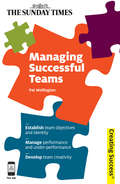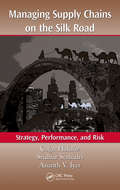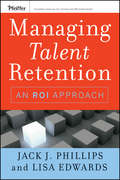- Table View
- List View
Managing Strategic Relationships
by Leonard GreenhalghContrary to the gospel of a century of management thinkers, the primary job of the manager is no longer to plan, organize, direct, or control, asserts management expert Leonard Greenhalgh. Instead, he argues, today's successful managers are primarily negotiators who are judged on their ability to foster, coach, protect, and support collaborative relationships -- and manage conflict -- with peers, workers, bosses, suppliers, customers, regulators, competitors, and stakeholders. In one of the most comprehensive analyses of business relationships ever written, Greenhalgh shows how relationships -- not technology or "know-how" -- are the foundation of the new extended enterprise. In immensely readable prose, he describes how companies have moved beyond adversarial relationships of command-and-control hierarchies to a new communal world in which internal networks of autonomous professionals and external networks of collaborating organizations compete against rival networks. In order to manage, managers must acquire a whole new set of negotiating skills, he argues. Traditional negotiating techniques promoted winning and self-interest, leaving a wake of bitterness and acrimony. Here Greenhalgh introduces for the first time a brilliant concept he calls "Commonwealth," which promotes ongoing relationships and the common interest. Using scores of detailed case studies and examples, he offers a set of cutting-edge tools managers can apply immediately to repair and improve relationships between people at all levels of responsibility, between groups, between organizations themselves, and between personalities involving gender differences. Timely, stimulating, and powerful, Managing Strategic Relationships is essential reading for every manager who hopes to succeed in the organization of today.
Managing Stress (Practice Manuals for Busy Professionals)
by Neil ThompsonThe Managing Stress Practice Manual, 2nd ed, provides the ideal stress management tool for practitioners across the public sector and professionals at all levels in business and management.The modern world of work is highly pressurised, with stress levels affecting workers' health and little to no understanding of the roots of stress, making workers feel overwhelmed and lacking the confidence to do anything about it. This book takes a holistic look at stress, offering clear and practical guidance on how to manage pressure, how to prevent stress, what to do if stress arises and how to deal with the aftermath of stress. By taking a deeper look, this book provides the reader with a full understanding, taking the narrow focus away from the individual themselves, and thereby taking away the 'blame the victim' message that can add to stress.This latest edition features new content including: current pressures caused by Covid-19, stress related to job insecurity, financial stress and the cost of living crisis issues around neurodiversity. It explains complex ideas clearly and accessibly, including practical examples and exercises throughout, with a repertoire of strategies and sources of help that will be invaluable to practitioners and business professionals alike.
Managing Stress in the Workplace (Institute of Learning & Management Super Series)
by Institute of Leadership & ManagementSuper series are a set of workbooks to accompany the flexible learning programme specifically designed and developed by the Institute of Leadership & Management (ILM) to support their Level 3 Certificate in First Line Management. The learning content is also closely aligned to the Level 3 S/NVQ in Management. The series consists of 35 workbooks. Each book will map on to a course unit (35 books/units).
Managing Subordinates' Performance: The Interpersonal Challenges Facing New Managers
by Linda A. HillManaging people is a delicate art, and the skills necessary to manage subordinates' performance don't come easily to new managers. There are many interpersonal challenges that you'll need to be prepared to deal with in your new role. For instance: How do you manage a subordinate who has more experience than you do? How should you approach rewards and discipline? How do you manage someone whose performance is sub-par? How can you delegate effectively? Author Linda A. Hill followed nineteen new managers through their first year, gathering data about the managerial transition. In this chapter, these managers develop and refine their interpersonal skills in four areas: accepting the diversity of their subordinates, responding to that diversity, managing the problem subordinate, and delegation and control. This chapter was originally published as Chapter 5 of "Becoming a Manager: How New Managers Master the Challenges of Leadership."
Managing Successful Teams (Creating Success #32)
by Pat WellingtonWith the shift of emphasis from the West to emerging economies such as China, Brazil and India, organisations need to restructure to adapt to the new global economy. Teams and projects are increasingly being scattered all over the world, and a manager operating in this environment can't connect face to face with people in their team. Not only will managers need to adapt to develop their skills for new environments, they will have to work better, quicker and faster. Managing Successful Teams prepares you to meet the challenges of building and leading teams, showing you how to improve performance and achieve the best results. Offering valuable advice and instant strategies, it covers each aspect of managing teams in new cultural shifts, including developing team creativity and innovation, realigning the teams identity with your leadership style and effective team leadership. The only book on the market to incorporate emerging trends and shifts in business practice, Managing Successful Teams addresses the practical and realistic issues you face in your everyday working life.
Managing Supply Chain Risk: Integrating with Risk Management
by Bret Wagner Sime Curkovic Thomas ScannellRisk management in supply chain logistics has moved from being a nice-to-have to a necessity due to the number of variables that can cripple a business. Managing Supply Chain Risk: Integrating with Risk Management details the critical factors involved in managing supply chain risk. It discusses how managing supply chain risk can be integrated into
Managing Supply Chains on the Silk Road: Strategy, Performance, and Risk
by Sridhar Seshadri Çağri Haksöz Ananth V. IyerHistorically important trade routes for goods of all kinds for more than 3000 years, the Silk Road has once again come to prominence. Managing Supply Chains on the Silk Road: Strategy, Performance, and Risk present emerging supply chain practices from the Silk Road regions that include China, Hong Kong, India, Pakistan, Iran, Central Asia, Lebanon,
Managing Sustainability
by Alan S. GuttermanManaging Sustainability is a comprehensive guide to governing, leading, and managing a successful sustainability-focused business. Being a socially and environmentally responsible business is a worthy goal for many people; however, turning the goal into reality is a daunting process. This book takes a clear and practical approach to the “nuts-and-bolt” of achieving this goal, and covers steps to be taken by directors and executives to create and implement appropriate strategies, policies, and management systems. It recognizes that corporate social responsibility (“CSR”) is like any other important management initiative and requires proactive leadership from the top of the organization. Key topics include: • Understanding how CSR is changing the traditional fiduciary duties of directors and officers • Developing and implementing internal governance instruments to provide a foundation for decision-making around CSR • Integrating CSR into the duties and responsibilities of the chief executive officer and other members of the C-suite team, as well as into their compensation arrangements • Conducting continuous audits and assessments of the sustainability governance and management framework using certification and rating systems to evaluate and improve CSR performance and effectiveness Current and aspiring leaders wishing to build a sustainability-centered business will appreciate the straightforward and actionable guidance offered by this book.
Managing Sustainability: Perspectives From Retailing and Services (International Series in Advanced Management Studies)
by Beatrice Luceri Elisa MartinelliCompanies and policy makers are prioritizing environmental, social, and governance goals as part of their strategies. Academic research has started to focus on these issues, but many important matters require deeper investigation and reflection, especially in specific sectors. This book focuses on the sustainability issues within the retailing and services sectors. Starting the discussion around research-knowledge on CSR, the authors discuss the strategic aspects of managing sustainability in retailing and service companies and offer recommendations to effectively manage the marketing levers for sustainability. Readers will benefit from an in-depth analysis of the social responsibility practices of major retailers and their strategies. The authors also take an inside view of CSR by studying the angles of employee perception and job satisfaction, financial performance, and the more recent impact of COVID-19. Using this approach, they highlight the system of relationships existing between stakeholder-related concepts and organizational factors and how they affect sustainability strategy.
Managing Sustainable Business Relationships in a Post Covid-19 Era: Towards a Dodecahedron Shaped Stakeholder Model (SpringerBriefs in Business)
by Vijay Pereira Yama Temouri Daicy VazThis book explores how the Covid-19 pandemic has impacted businesses of all types around the world. It investigates and consolidates the relationships that businesses have with their key stakeholders in order to shed light on the complexity of the challenges and corresponding solutions. The authors identify 12 key stakeholders and, utilizing the stakeholder theory, argue for a Dodecahedron shaped stakeholder model being prevalent wherein each stakeholder group has equal stake in importance and a need for all to cooperate in their relationships. Featuring examples for each type of business relationship (e.g., B2B, consumer, government, stakeholder), this book offers researchers, students, scholars and policy makers a framework for creating resilience in business relationships during current and future crises.
Managing Sustainable Business: An Executive Education Case And Textbook
by N. Craig Smith Gilbert G. LenssenThis book offers 32 texts and case studies from across a wide range of business sectors around a managerial framework for Sustainable Business. The case studies are developed for and tested in executive education programmes at leading business schools.The book is based on the premise that the key for managing the sustainable business is finding the right balance over time between managing competitiveness and profitability AND managing the context of the business with its political, social and ecological risks and opportunities. In that way, a sustainable business is highly responsive to the demands and challenges from both markets and societies and managers embrace the complexity, ambivalence and uncertainty that goes along with this approach.The book presents a framework that facilitates the adoption of best business practice. This framework leads executives through a systematic approach of strategic analysis and business planning in risk management, issues management, stakeholder management, sustainable business development and strategic differentiation, business model innovation and developing dynamic capabilities. The approach helps broaden the understanding of what sustainable performance means, by protecting business value against sustainability risks and creating business value from sustainability opportunities.
Managing Sustainable Development
by Ian Christie Michael CarleyIn a world where environmental problems spill across political, administrative and disciplinary boundaries, there is a pressing need for a clear understanding of the kinds of organizations, management structures and policy-making approaches required to bring about socially equitable and ecologically sustainable development. In this second edition, the authors incorporate lessons from a decade of work on the conditions of sustainability in both developed and developing countries. They prescribe action networks - partnerships of flexible, achievement-oriented actors - and present new case studies demonstrating the success of organizations that have applied this approach. They also introduce case studies on action networks that work simultaneously on international, national and local levels.
Managing Sustainable Innovation
by Ian E. MaxwellIan Maxwell applies decades of research and application to present a novel approach to innovation, with an emphasis on sustainable and renewable practices that benefit many, and not just a handful of executives and shareholders. Featuring examples from a wide range of innovators around the world, from Google to Genentech to the Masdar "clean" city initiative in Abu Dhabi, Maxwell argues that organizations that embrace structured innovation management systems and drive a "top down" innovation culture will achieve sustainable high growth and strong shareholder returns. Countries that provide the right physical, financial and human resource infrastructure to support a highly innovative macro-economic environment will experience both strong GPD growth and high living standards. Those companies and countries that fail to support innovation will struggle to compete and raise living standards, respectively. Maxwell considers the cases of China and India, whose low-cost innovation strategies are posing a serious competitive threat to established multinationals in the developed world, and considers the impact of innovation on such timely issues as climate change, environmental pollution, fossil fuel shortages, third world poverty, rising healthcare costs and ageing populations.
Managing Sustainable Innovation (Innovation and Technology Horizons)
by Vanessa Ratten Marcela Ramirez-Pasillas Hans LundbergThis book is an insightful text looking at sustainable innovation and the emerging fourth sector, i.e. hybrid organizations, through an interdisciplinary approach. The book illuminates what hybrid organizations are and how they generate new ways of creating blended value to secure the well-being of future generations and preservation of ecological services. The book also discusses how sustainable innovation may offer creative solutions to societal issues, the sharing economy and the circular economy. This book will appeal to those taking MBA and EMBA programmes, and those with an interest in creating sustainable business and innovation solutions.
Managing Sustainable Luxury and Digitalization: Technology Trends and Ethical Challenges in the Swiss Luxury Watch Business (Routledge Studies in Luxury Management)
by Peter Seele Mario D. SchultzThis book offers new transdisciplinary perspectives on luxury, exploring the topical phenomenon of digitally retouched (censored) and blockchain-secured (sensored) luxury watches and outlining implications that emerge for the field of luxury studies and managerial practice.Based on a cross-disciplinary approach, the book integrates theoretical and empirical perspectives to advance the readers’ understanding of luxury. With a particular focus on the Swiss luxury watch context, the book thereby draws on qualitative, quantitative, and archival data to shed new light on recent luxury trends, integrating literature on aesthetics of labour, conspicuous consumption, Gestalt theory, ethical theory, functional theories of attitudes, and surveillance studies. Eight chapters take the readers through a range of topical challenges arising with the display and changing moral perceptions of luxury and shifts that the luxury watch sector is facing in light of the digital transformation impacting luxury goods and the luxury management environment.This unique book will be of value for academics, scholars, and upper-level students across management studies with a particular interest in the luxury and fashion industries, luxury management, brand management, business ethics, and digital transformation.With a foreword by Thomaï Serdari, Leonard N. Stern School of Business, New York University.
Managing Sustainable Performance and Governance in Higher Education Institutions: A Dynamic Performance Management Approach (System Dynamics for Performance Management & Governance #5)
by Federico CosenzThe fast-changing evolutionary process of global Higher Education systems systematically poses new challenges related to the appearance of innovative elements that lead academic governing bodies to question current managerial structures and methods. Due to this, theory and practice have gathered multiple contributions and experiences to support and further develop this evolutionary pathway during the past decades. Global competitiveness, economic and social growth are driven worldwide by knowledge and innovation. In this context, Higher Education Institutions play a crucial role as they primarily contribute to knowledge transfer and development and, as a result, foster regional development, employment, and economic wealth. The relevance of this role leads Universities to explore alternative solutions for managing their performance according to a sustainable perspective. This book draws on this flourishing debate on Higher Education policy and management and investigates an innovative systemic perspective to design and implement sustainable performance management systems for academic institutions. The conditions for the success of Universities, the critical issues underlying the creation of academic value, the dynamic complexity characterizing academic governance settings, the pluralistic audience of stakeholders and related expectations, the causal interplays between organizational performance variables, represent some of the central themes around which this work is developed. More specifically, the book suggests and discusses the adoption of a Dynamic Performance Management approach to frame the inherent organizational complexity of Higher Education Institutions, thus supporting a strategic learning perspective to design and implement relevant performance measures. This approach originates from the combination between conventional performance management and System Dynamics modeling. Many research and practice contributions prove that this methodological combination can boost the understanding and interpretation of value creation processes by identifying and exploring the causal connections amongst strategic resource allocation and consumption, corresponding performance drivers, emerging outputs, and outcomes. To test the effectiveness of this approach in University settings, a wide range of examples is offered in each book chapter. This allows readers to explore the advantages, limitations, and practical implications of adopting Dynamic Performance Management in Higher Education Institutions, as well as guide academic decision-makers towards a more robust approach to design and implement strategic management mechanisms in Universities.
Managing Sustainable Stakeholder Relationships: Corporate Approaches to Responsible Management (CSR, Sustainability, Ethics & Governance)
by Linda O'RiordanThis book examines corporate approaches to responsible management by investigating the stakeholder relationships between business and society. Though concepts of responsible management continue to evolve, its key objective is to explore the opportunities and dilemmas which business decision-makers face when attempting to reconcile their organisation’s interests with those of other stakeholder groups. In this intensely debated field, it focuses on the power of entrepreneurial purpose and the opportunities which emerge when corporate choices and actions are driven by connected stakeholder interests. A case study of the pharmaceutical industry in the UK and Germany is presented to reveal how decision-makers in this particular sector are responding to their context-specific management challenges. The research findings are subsequently employed to examine and revise a pre-specified stakeholder management framework which was previously developed by the author. The proposed updated framework is the book’s main conceptual contribution. By depicting a set of inclusive, integrated, and inter-related steps, it is intended to provide an innovative, comprehensive, practical toolkit for stakeholder management. As such, it is designed to help decision-makers to attain the greatest possible outcome from the resources they invest by consciously basing their choices not merely on the impacts for their shareholders, but also and more holistically for a broader range of stakeholders. Ultimately, the book demonstrates how optimally harmonised stakeholder management can serve as a powerful catalyst for unlocking viable business opportunities which serve the interests of business and society.
Managing Sustainable Tourism: A Legacy for the Future
by David L. Edgell SrManaging Sustainable Tourism tackles the tough issues within the tourism industry, such as impacts on the natural and built environment and concerns for the history, heritage, and culture of local communities to provide answers that produce positive and quality economic growth for the tourism industry. It offers practical policies and plans for fostering harmonious relationships among local communities, the private sector, not-for-profit organizations academic institutions, and governments at all levels, as well as developing management practices and philosophies for the protection of natural, built, and cultural environments while reinforcing positive and orderly economic growth. It also confronts and explains the challenges on the tourism industry with respect to overtourism, climate change and global warming. Since the second edition, there have been many important developments in the field of sustainable tourism, and this third edition presents updated research and information in the following ways: Updated content to reflect issues and trends, including new directions in sustainable tourism development; New and updated international case studies of successes and failures to reflect current challenges and practices; A partial history of sustainable tourism from ancient times to the present; New concepts in sustainable tourism practices such as overtourism and undertourism; Transformative leadership and policies and their impact on sustainable tourism development. This volume provides a wealth of information and guidance on managing sustainable tourism and it will be invaluable to educators, students, developers, entrepreneurs, strategic planners and policymakers.
Managing Sustainable Tourism: A Legacy for the Future
by David L. Edgell, SrIntelligently designed tourism strategies for the twenty-first century!Successful tourism development and marketing are dependent on maintaining a delicate balance between economic growth and the protection of environments. Managing Sustainable Tourism: A Legacy for the Future tackles the tough issues of tourism such as negative environmental impact and cultural degradation, and provides answers that don&’t sacrifice positive economic growth. This essential book offers practical plans for fostering harmonious relationships among local communities, the private sector, not-for-profit organizations, academic institutions, and governments at all levels as well as develops management practices and philosophies that protect natural, built, and cultural environments while reinforcing positive and orderly economic growth.Managing Sustainable Tourism discusses in-depth the sensible guidelines for protecting environment, heritage sites, and local culture while developing realistic tourism goals for compatible economic growth. Useful strategies for sustainable tourism are detailed for each tourism type, along with useful tried-and-true marketing techniques aimed at cooperation and respect for all types of environments. Case studies, research, and supplemental reading lists clearly illustrate ideas and the author&’s qualified suggestions.Managing Sustainable Tourism explores: the future of the tourism industry understanding sustainable tourism the economics of community growth through tourism marketing the sustainable tourism product nature tourism heritage tourism cultural tourism rural tourism practical guidelines for sustainable tourism a workable global sustainable tourism initiativeManaging Sustainable Tourism is an ideal resource for educators, students, developers, entrepreneurs, investors, tourism strategists, planners, policymakers, and anyone interested in sustainable tourism for the new millennium.
Managing Sustainable Tourism: A legacy for the future
by David L. Edgell SrManaging Sustainable Tourism tackles the tough issues of tourism such as negative environmental impact and cultural degradation, and provides answers that don't sacrifice positive economic growth. It offers practical plans for fostering harmonious relationships among local communities, the private sector, not-for-profit organizations, academic institutions, and governments at all levels as well as develops management practices and philosophies that protect natural, built, and cultural environments while reinforcing positive and orderly economic growth. Since the first edition, there have been many important developments in the field, and this second edition has been revised and updated in the following ways: Updated content to reflect issues and trends, including: impact of the internet, slow tourism, responsible tourism, pro - poor tourism and motivations of the individual tourist New and updated international case studies of successes and failures to reflect current challenges and practices New lecturer and student online resources including PowerPoint slides and practical scenarios. This volume provides a wealth of information and guidance on managing sustainable tourism now and in the future and will be invaluable to educators, students, developers, entrepreneurs, investors, tourism strategists, planners and policymakers.
Managing Systemic Banking Crises
by Marc Quintyn David S. HoelscherRecent financial sector crises and their resolution have raised new issues and provided additional experiences to draw on in the future. Banking sector problems in Russia, Turkey, and a few Latin American countries occurred within the context of highly dollarized economies, high levels of sovereign debt, severely limited fiscal resources, or combinations thereof. These factors have challenged the effectiveness of many of the typical tools for bank resolution. Managing Systemic Banking Crises focuses on the issues raised in systemic crises, not on the resolution of individual bank problems. Based on the lessons learned during the Asian crisis, it updates the IMF's work on the general principles, strategies, and techniques for managing these crises.
Managing Talent Pipelines in the Future of Work
by William R. Kerr Manjari Raman Joseph B. Fuller Carl KreitzbergIn the face of a rapidly-changing economy, organiztions that wish to compete in the future of work must develop strategies for acquiring, retaining, and developing talent for their organizations. This primer reviews the major trends shaping jobs, workplaces, and worker demographics. It then discusses many of the largest weaknesses in traditional talent management systems. The case then closes by describing how firms can create "talent management pipelines." In this framework, firms' core asset - talent - is subjected to the same quality-management proceudres that revolutionized global supply chain practices in the 20th century.
Managing Talent Retention
by Edwards Lisa Phillips Jack J.Retention is becoming one of the most pressing concerns of employers worldwide. This book provides an overview of talent retention and defines retention and turnover in very specific measures. It explores the full impact of talent departure and most important it offers proven solutions to talent retention. The book clearly shows how to forecast the ROI of talent retention solutions and how to capture the actual ROI after the solution was implemented. This is a practical book providing an ROI approach to HR managers and practitioners.
Managing Talent: A Short Guide for the Digital Age
by Mike Rugg-GunnRecruiting, selecting, retaining and developing great people are essential for any successful business. And the combination of digital transformation and post-pandemic work realities presents major challenges for all organisations. This book provides best practice talent management guidance for businesses undertaking digital transformation or facing digital disruption. Taking the reader through the stages of talent acquisition, selection, retention and development, this practical and concise book: sets out, assesses and predicts how the digital revolution impacts talent management practices, and helps the reader navigate the journey from an analogue to a digital organisation; updates talent management concepts and illustrates these with examples and cases of best practice across the business world; and enables senior leaders, talent management professionals and managers to quickly access and implement key learnings through the use of practitioner point summaries and a set of Ten Top Tips in each relevant chapter. The book provides practical insights, grounded in research, into how to manage talent in a fluid and dynamic world of digital change and is aimed at senior leaders and managers, and the HR community. It clearly shows how organisations undertaking a digital journey need to flex and adapt their talent management processes.
Managing Talent: A Short Guide for the Digital Age
by Mike Rugg-GunnRecruiting, selecting, retaining and developing great people are essential for any successful business. And the combination of digital transformation and post-pandemic work realities presents major challenges for all organisations. This book provides best practice talent management guidance for businesses undertaking digital transformation or facing digital disruption. Taking the reader through the stages of talent acquisition, selection, retention and development, this practical and concise book: sets out, assesses and predicts how the digital revolution impacts talent management practices, and helps the reader navigate the journey from an analogue to a digital organisation; updates talent management concepts and illustrates these with examples and cases of best practice across the business world; and enables senior leaders, talent management professionals and managers to quickly access and implement key learnings through the use of practitioner point summaries and a set of Ten Top Tips in each relevant chapter. The book provides practical insights, grounded in research, into how to manage talent in a fluid and dynamic world of digital change and is aimed at senior leaders and managers, and the HR community. It clearly shows how organisations undertaking a digital journey need to flex and adapt their talent management processes.





















